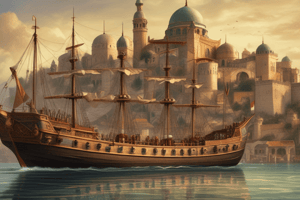Podcast
Questions and Answers
What year did the fall of Constantinople occur?
What year did the fall of Constantinople occur?
- 1453 (correct)
- 1460
- 1450
- 1445
The population of Constantinople increased from 40,000 to 50,000 in the 1450s.
The population of Constantinople increased from 40,000 to 50,000 in the 1450s.
False (B)
Who was the leader of the Ottoman Empire during the fall of Constantinople?
Who was the leader of the Ottoman Empire during the fall of Constantinople?
Sultan Mehmed II
The Ottoman siege of Constantinople lasted ___ days.
The Ottoman siege of Constantinople lasted ___ days.
Match the following historical events with their significance:
Match the following historical events with their significance:
What was one significant consequence of the fall of Constantinople for the Ottomans?
What was one significant consequence of the fall of Constantinople for the Ottomans?
Constantinople was the last stronghold of the Ottoman Empire against Christian Europe.
Constantinople was the last stronghold of the Ottoman Empire against Christian Europe.
What was the symbolic value of capturing Constantinople for the Ottomans?
What was the symbolic value of capturing Constantinople for the Ottomans?
The population of Constantinople had reduced to around ___ by the 1450s.
The population of Constantinople had reduced to around ___ by the 1450s.
Which empire was known as the eastern continuation of the Roman Empire?
Which empire was known as the eastern continuation of the Roman Empire?
Flashcards are hidden until you start studying
Study Notes
Fall of Constantinople
- Occurred in 1453, marking the end of the Byzantine Empire and the rise of Ottoman power.
- Strategically located between Europe and Asia, Constantinople was a vital center for trade and culture for centuries.
Decline of the Byzantine Empire
- Experienced a long decline, facing external threats and internal turmoil leading up to the 15th century.
- By the time of its fall, the Empire's territory had contract to Constantinople and its immediate surroundings.
Demographics
- Population decreased dramatically from 400,000 in the 12th century to approximately 40,000-50,000 by the 1450s.
Ottoman Expansion
- Under Sultan Mehmed II's leadership, the Ottoman Empire expanded across the Balkans and Anatolia.
- Constantinople was considered crucial not only for its strategic significance but also as the last Christian stronghold against Ottoman advancement.
Siege of Constantinople
- The siege lasted 55 days, marked by relentless bombardment using advanced Ottoman cannons.
- Byzantine defenses were overwhelmed despite their brave resistance.
Historical Impact of the Fall
- The city fell on May 29, 1453, leading to the end of the Byzantine Empire.
- Ottomans gained control over critical trade routes like the Silk Road, enhancing their economic power and influence.
- Established dominance in the eastern Mediterranean, leading to further territorial expansion.
Cultural Transformation
- Transitioned from a center of Christian culture to a hub of Islamic learning under Ottoman governance.
- The city's name was changed to Istanbul, becoming the capital of the Ottoman Empire, symbolizing the cultural shift.
Studying That Suits You
Use AI to generate personalized quizzes and flashcards to suit your learning preferences.




